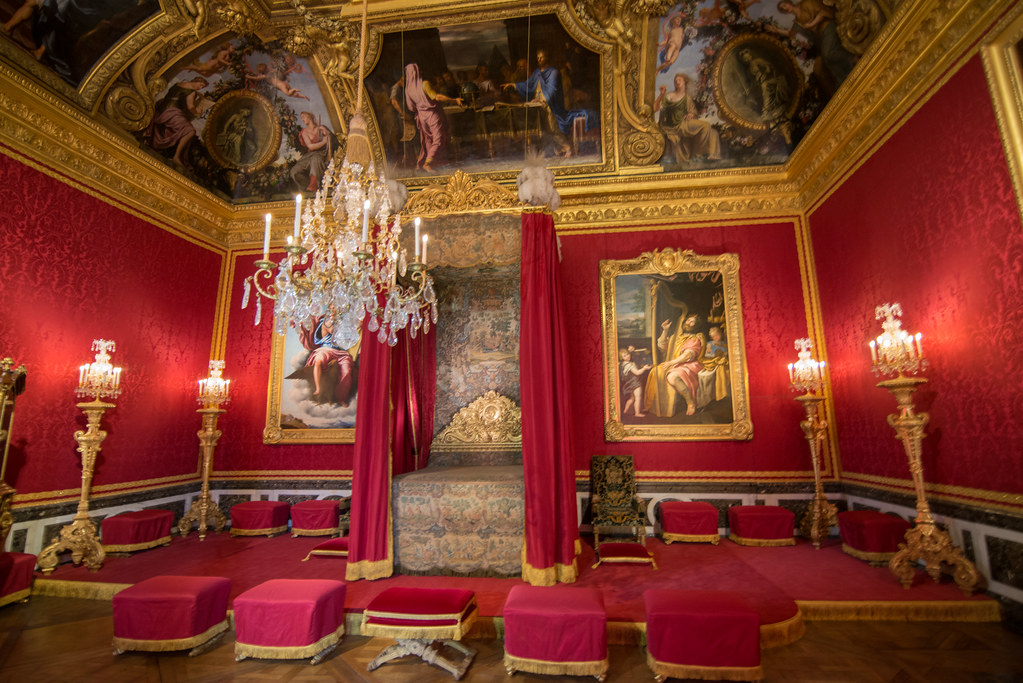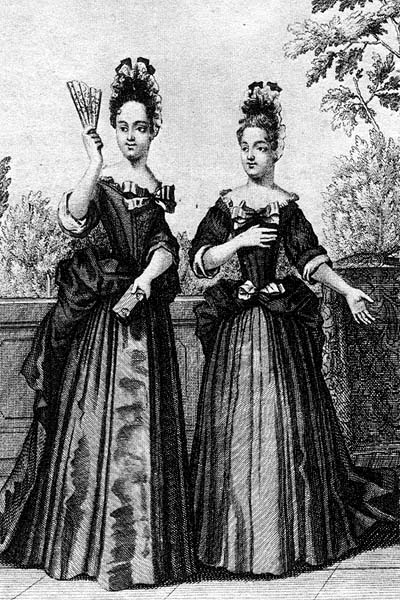How and when to sit….
At Louis XIV’s court even the most simple of tasks, like placing one’s behind on a piece of furniture designed for it, was an utterly complicated matter at times. Not just was it very important how one sat down, sitting down at the wrong time on the wrong chair could mean one’s ruin.

Who could sit where and when was dictated by etiquette and depended on rank, title and situation. It was a very serious matter. So serious that private wars were fought over whose wifey had to stand or sit in whose presence and whose wifey had to rise in order to make space for someone higher ranking. Even the act of sitting itself had rules of how it was to be done in the most fashionable and elegant way.
When sitting down, a gentleman would do so by sliding his left foot in front of the right and using the arms to assist in lowering the behind. This was done quite slowly for a practical reason… as tighter breeches came into fashion, sitting down too fast could force them to split in a delicate area. The females did not have this issue, obviously, but they had to deal with discreetly arranging the sometimes voluminous hind-parts of their gowns in a way that ensured they would not get flattened by sitting on them. Male or female, crossing ones legs when at court was a no go. One had to sit with ones back being straight and both feet on the ground. The arms should be placed elegantly and in a way the inside of the wrists could be seen. The skin there is very delicate and allows the blue of the veins to be seen, the paler the skin and the bluer the veins, the more handsome. Unless it is ones own home, sitting down just like that without invitation, is very bad manners. A seat must always be offered first. In the salons at court, one could sit down without invitation, but here is where it gets quite complicated.
As with many other matters, precedence played a big role in matters of sitting and not everyone was allowed to sit in the presence of certain people. Something called the honours of the Louvre played a big role here. Those honours are a list of things to which those that had been granted the the honours of the Louvre were entitled, for example to kneel on a certain kind of cushion at mass when the King was present or to sit on a tabouret.
Only the Queen and King had the right to sit on a fauteuil, a chair with arms, this did also apply to foreign Monarchs and made matters a little complicated in case of the exiled English Monarchs. The exiled James II and his Queen, for example, had the right to fauteuils and as James II died, Louis XIV granted this right to James’ son James Francis Edward Stuart aka the Old Pretender, therefore basically making him a proper King, although England had William III.

Chairs without arms but with a backrest, were for the members of the Royal Family. Including the King’s brother and his wife as well as the Children of France. During Louis XIV’s reign it was common for his sons to stand, while his daughters sat.
Tabourets, or stools, were for the Duchesses. Everyone else had to stand.
So far it is not too complicated, but it will get now… If the Queen was alone, meaning the King was not with her, Cardinals could take a seat on a stool, while in presence of the King they were required to stand. In presence of the King, the Children and Grandchildren of France were allowed to sit, but only on a stool and not a chair. Princes of the Blood had to stand, but Princesses and Duchesses were allowed to sit on a stool.
If both Queen and King were not present, the rules changed completely. In presence of the Dauphin, his siblings the Children of France could sit on an armchair, while the Grandchildren of France, Cardinals, Princesses of the Blood and Duchesses were entitled to tabourets.
If the Dauphin was not present, but one of his children was, the rules changed again. In presence of a Grandchild of France, all those of equal rank were granted armchairs. The Princes and Princesses of the Blood, Cardinals and Duchesses had the right to chairs with backs in this case and Ducs were allowed to sit as well, but only on a tabouret.
In Presence of Princes and Princesses of the Blood, armchairs were granted to Cardinals, Ducs and Duchesses. In this case, men and women of quality could sit on a tabouret.





5 Comments
Mary
maybe you could recommend me of etiquettes written from 17th century ? or poems about the women and court?
i really like your great site ,all about the court and mistress is very interesting
thank you
Aurora von Goeth
Thank you for reading. There isn’t really any kind of book that has all etiquette in it, as for poems and such if you speak French you can find some in he online archives. Or check out the works of the great writers of the time. Some of it is available for free as ebook.
Mary
ok thank you
Paulo Furtado
I assume that all these etiquette rules have not been written by just one person, I remember reading somewhere that Cardinal Richelieu was the first to establish table manners in France. Anyway, thank you for sharing this information and if I may, I would recommend the book “Le Cannaméliste Français” to anyone who is interested about table manners, presentations of dishes, utensils, and furniture at banquets at this time
Thaddeus Howze
Thanks for the article. It inspired me to think about historical novels in a new light. It even inspired my Story-A-Day May juices to create a short story around the idea. I gave you credit for the inspiration: https://medium.com/@ebonstorm/a-bright-empire-824a3c7379c7